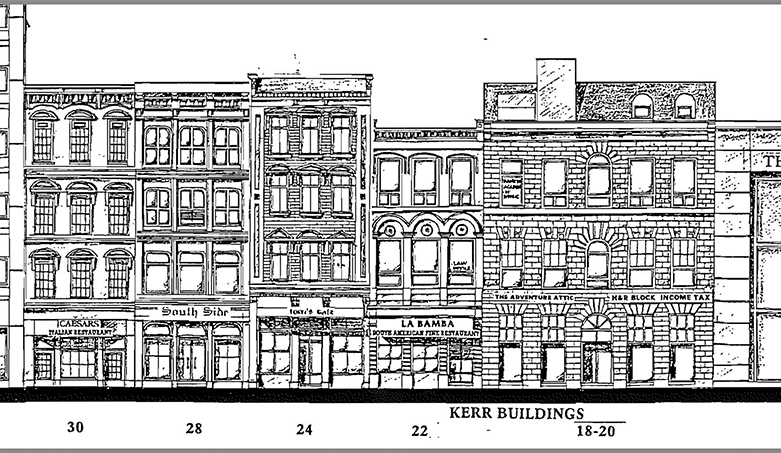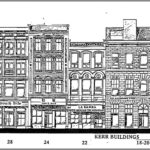
The Gutting of the Gore
- Carol Priamo
- 07 Feb 2017
On January 25th, after a long four year process and much debate, Hamilton City Council voted to approve the demolition of four heritage buildings on the south side of Gore Park. After years of demolition by neglect, the properties will be torn down and mostly replaced. The remaining pre-Confederation facades of 18-22 King Street East will be restored with the help of City grants. This is simply reward for neglect, a routine that has become all too common in Hamilton. Again and again it results in boarded-up, deteriorating heritage buildings which become eyesores and embarrassments to all of us. Unfortunately, when properties are neglected and fall into such disrepair, it’s often impossible for many people to see the heritage value or future potential these buildings hold.
HISTORY
In many ways, our buildings provide the strongest tangible evidence of Hamilton’s history. When you remove the buildings, you remove the history. Built in the early 1840’s, 18 – 22 King Street East, were among to earliest establishments in the Town of Hamilton, which had been laid out by George Hamilton in 1816. The buildings are located on what was the northern border of this town, in a prime location adjacent to the dirt track of James Street North, which led to the harbour. The buildings at 18 – 20 King Street East were operated by the Kerr brothers as a wholesale dry goods store.
Theirs was one of the most successful businesses in Hamilton, supplying Hamiltonians and new immigrants with all that they needed to set up and maintain their homes and farmsteads. Now among the few remaining buildings in Gore Park that date to before Confederation, they are rare and significant to the earliest history of our city. The buildings at 18 – 22 were designed by renowned architect, William Thomas, who had designed St. Lawrence Hall and St. Michael’s Cathedral in Toronto and the Brock Monument in Queenston. They are of a Georgian style with classical proportions, order and symmetry, while 22 King Street East display the Renaissance Revival style with a high degree of craftsmanship. The dressed limestone blocks of the walls are from a nearby quarry.
The two 1870’s buildings at 24 and 28 King Street East were built when the City began to beautify the Gore area which was then named Gore Park. It soon became very successful as a thriving commercial and social gathering place in the centre of the new city. These buildings are in the high Victorian commercial style and display many preserved decorative details from this period.
Together, these four buildings housed the first businesses that sprang up around the Gore and were the foundation of what became a major North American manufacturing centre in the 19th and early 20th centuries. They define the character of Gore Park, providing it with an historic enclosure on the south side, and are an integral element in the 19th century commercial streetscape that progressed along King Street East from James to Wellington Street

THE LONG AND WINDING ROAD
It has been a long and arduous journey from 2012 when demolition permits for these properties were requested by their owner/developer until the final pronouncement by Council on January 25, 2017. Now, unless the process is stopped at a higher level, the site will be redeveloped to suit the developer, and a clean-line, boxy structure will replace our Gore history. As a part of the “compromise” the stone facade of the earliest buildings at 18 – 22 King Street East will be retained and incorporated into the ‘modern’ development. (This is a compromise that too often has good intentions, but poses a high risk for damaging or completely losing the historic facades in the process). During this long four year process, during which the owner vacated the buldings and left them exposed to the elements, the properties have deteriorated behind their hoarding, resulting in a sad and disgraceful site on Gore Park.
For our readers who may not be familiar with these developments and those who have tried to piece together the complete saga of this proposed development here are the highlights of this process:
• December 2012: Wilson Blanchard makes application for demolition permits for 18 – 22 as well as 24 and 28 King Street East. The permits are granted but public outcry pressures City Hall to review the decision.
• Demolition is halted, and by the end of 2013 Council approves designation of the buildings as historically and architecturally significant. The developer challenges the designation, vacates the occupants of his properties and boards the buildings up.
• Throughout 2014 – 2015, negotiations with Council produce a revised site plan with the facade of 18 – 22 King Street East (the pre-Confederation buildings) incorporated into the new modern structure. The Victorians at 24 & 28 King Street East are not included.
• In April 2016 Council is satisfied with a revision of the first design and submits it to their Planning Staff for a report regarding how to move forward. Planning Staff recommends demolition of 24 and 28 King Street East and partial demolition of 18 – 22 King Street East.
• The reports are submitted to the Municipal Heritage Committee (which advises Council on matters of heritage importance) at their meeting on December 16, 2016, where a vote is taken on whether to grant the owner demolition permits. The committee opposes demolition for any of the buildings, however Council is still in favour of the developer’s plan.
• The January 17, 2017 meeting of the Planning Committee includes delegations from heritage organizations, neighbourhood associations, and architects presenting very thorough cases for saving the Gore Heritage buildings. The vote is 6 – 3 in favour of demolition, full and partial. Final approval is granted by Council and at their January 25 meeting. The developer’s demolition requests are approved, conditional upon the developer having a site plan approved by the Director of City Planning and beginning the construction within five years.
CAN THE GORE BE SAVED?
At this point, the best option is through appeals to the Provincial Government through the Minister of Tourism, Culture and Sport to intervene and mediate as was the salvation of the Lister Block.
Comments 0
There are no comments




Add comment